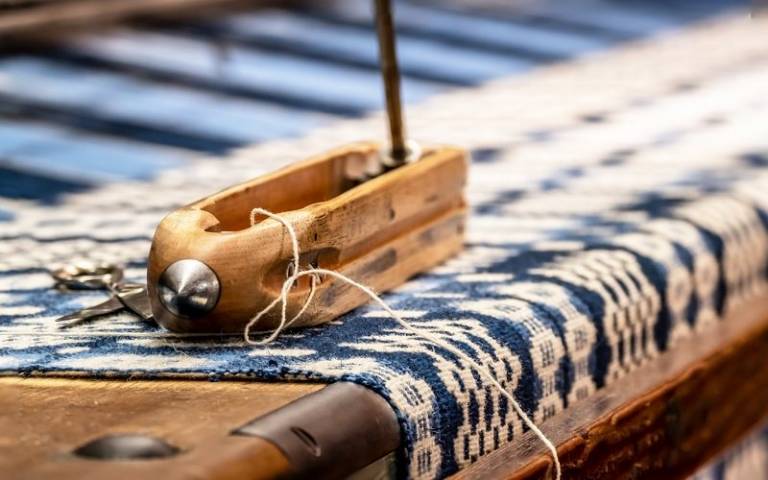Changing public perceptions of textiles in modern art museums
In 2018, UCL’s Professor Briony Fer co-curated the first exhibition in a leading modern art museum exclusively on a textile artist, helping to transform public understanding of the art of weaving.

28 April 2022
Professor Briony Fer is a leading art historian, critic, curator and Fellow of the British Academy - based in UCL’s History of Art Department.
She has helped to transform knowledge and understanding of the place of weaving, and textiles more broadly, within the history of modern art and across curatorial, arts and public spheres.
A watershed moment for a textile artist
In 2018, Professor Fer co-curated a major retrospective exhibition of Bauhaus weaver Anni Albers (1889-1994), introducing the work of an overlooked woman artist who used textiles as her medium to an exhibition-going audience. It marked a watershed as the first exhibition at Tate Modern (or indeed in any of the world’s leading modern art museums) to focus exclusively on a textile artist, influencing the strategic direction of the museum and expanding the scope of its collection.
By breaking down traditional divisions between art, craft and design, the exhibition transformed the cultural dialogue on the role of woven textiles in modern and contemporary art and life for exhibition visitors, fashion and textiles practitioners and professionals.
Professor Fer was initially invited by the Director of Tate Modern to co-curate their Anni Albers exhibition on the strength of her innovative research re-thinking the geographies and narratives of modernism, from the development of geometric abstraction to contemporary art, including her monograph The Infinite Line, Yale University Press, 2004.
From 9 June to 9 September 2018, K20 gallery in Dusseldorf showed the exhibition ‘Anni Albers’. It then moved to Tate Modern, London, where it ran from 11 October 2018 to 27 January 2019. Both were co-curated by Professor Fer together with Ann Coxon (Tate) and Maria Müller-Schareck (K20) and sought to recognize Albers’ contribution to modern art and design.
A modern view on an ancient craft
Anni Albers has been doubly marginalized, first as a woman artist conventionally seen as subordinate to her more famous husband, the Bauhaus artist Josef Albers, and second because her medium was weaving and therefore traditionally seen as craft, not art.
In original research conducted for the exhibition catalogue, Professor Fer argued that weaving, though an ancient craft, is also distinctively modern, thereby offering a fresh account of the history of modernism and showing how a woman weaver was at the forefront of the modern project.
Professor Fer situates Anni Albers as an artist who used weaving as other artists used painting: to articulate a set of beliefs about the world they lived in.
The atlas of world weaving conceived of by Professor Fer, and at the heart of the exhibition, included examples of Albers’ own collection of textiles from Latin America, as well as woven items from Africa and Japan.
The display resisted a problematic primitivist appropriation of the art of other cultures, instead exploring the rich archive of Albers’ book On Weaving to trace the complexities of a modern aesthetic in relation to both an ancient and a modern global culture.
Research synopsis
Transforming public understanding of Anni Albers and changing perceptions of the significance of weaving and textiles in the modern art museum
In 2018 Professor Briony Fer co-curated a major retrospective exhibition of Bauhaus weaver Anni Albers, introducing the work of an overlooked woman artist who used textiles as her medium to an exhibition-going audience. It marked a watershed as the first exhibition at Tate Modern (or indeed in any of the world’s leading modern art museums) to focus exclusively on a textile artist, influencing the strategic direction of the museum and expanding the scope of its collection. By breaking down traditional divisions between art, craft and design, the exhibition transformed the cultural dialogue on the role of woven textiles in modern and contemporary art and life for exhibition visitors, fashion and textiles practitioners and professionals.
Links
- Professor Bryony Fer’s academic profile
- UCL History of Art
- UCL Faculty of Social & Historical Sciences
- UCL Social & Historical Sciences REF 2021
Image
- Image credit: iStock/Lukassek
 Close
Close

